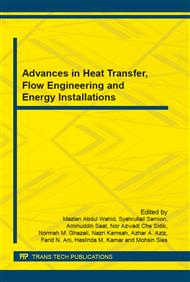[1]
C. Speziale, R. So dan B. Younis, On the prediction of turbulent secondary flows, Hampton, Virginia, (1992).
Google Scholar
[2]
A. Escue dan J. Cui, Comparison of Turbulence Models in Simulating Swirling Pipe Flows, Applied Mathematic Modelling, vol. 34, pp.2840-2849, (2010).
DOI: 10.1016/j.apm.2009.12.018
Google Scholar
[3]
S. Berger dan L. Talbot, Flow in curved pipes, Ann. Rev. Fluid Mech, vol. 15, pp.4611-512, (1983).
Google Scholar
[4]
H. Tennekes dan J. Lumley, A First Course In Turbulence, 3 rd penyunt., MIT Press, (1974).
Google Scholar
[5]
B. Launder dan D. Spalding, The Numerical Computation of Turbulent Flows, Computer Methods in Applied Mechanics and Engineering, vol. 3, pp.269-289, (1974).
DOI: 10.1016/0045-7825(74)90029-2
Google Scholar
[6]
V. Yakhot dan S. A. Orszag, Renormalization Group Analysis of Turbulence. I. Basic Theory, Journal of Scientific Computing, vol. 1, no. 1, pp.3-51, (1986).
DOI: 10.1007/bf01061452
Google Scholar
[7]
S. Thangam, Analysis of two-equation turbulence models for recirculating flows, ICASE Report No. 91-61; Contract No. NASI-18605, Langley, Virginia, (1991).
Google Scholar
[8]
C. Hrenya, E. Bolio, D. Chakrabarti dan J. Sinclair, Comparison of Low Reynolds Number k-epsilon Turbulence Models in Predicting Fully Developed Pipe Flow, Chemical Engineering Science, vol. 50, no. 12, pp.1923-1941, (1995).
DOI: 10.1016/0009-2509(95)00035-4
Google Scholar
[9]
A. Balabel dan W. El-Askary, On the performance of linear and non-linear k-e turbulence models in various jet applications, European Journal of Mechanics B/Fluids, vol. 30, pp.325-340, (2011).
DOI: 10.1016/j.euromechflu.2010.10.006
Google Scholar
[10]
S. Darmawan, A. I. Siswantara dan Budiarso, Comparison of turbulence model on Reynolds numbers of a Proto X-2 Bioenergy Micro Gas Turbine's compressor discharge, dalam International Conference on Engineering of Tarumanagara, Jakarta, (2013).
Google Scholar
[11]
S. Darmawan, Budiarso dan A. I. Siswantara, CFD Investigation of STD k-e and RNG k-e turbulence model in compressor discharge of proto x-2 bioenergy micro gas turbine, dalam The 8th FTEC, Yogyakarta, Indonesia, (2013).
DOI: 10.4028/www.scientific.net/amm.819.392
Google Scholar
[12]
H. Versteeg dan W. Malalasekara, An Introduction to Computational Fluid Dynamics, The Finite Volume Method, 2 penyunt., Essex: Pearson Educational Limited, (2007).
Google Scholar
[13]
F. Inc., Fluent 6. 3 User's Guide, Lebanon, (2006).
Google Scholar
[14]
Budiarso, A. I. Siswantara dan S. Darmawan, Secondary Flow pada pipa keluar kompresor Turbin Gas Mikro Bioenergi Proto X-2: Analisis dengan model turbulen STD k-e dan RNG k-e, dalam SNTTM (Seminar Nasional Tahunan Teknik Mesin) XII, Bandar Lampung, (2013).
DOI: 10.35814/asiimetrik.v4i1.3100
Google Scholar
[15]
TM-107, Introduction to the Renormalization Group Method and Turbulence Modeling, Fluent Inc., Lebanon, (1993).
Google Scholar
[16]
S. Thangam dan C. Speziale, Turbulent Flow Past a Backward-Facing Step: A Critical Evaluation of Two-Equation Models, AIAA Journal, vol. 30, no. 5, (1992).
DOI: 10.2514/3.48951
Google Scholar
[17]
S. Khani dan M. L. Waite, Effective eddy viscosity in stratified turbulence, Journal of Turbulence, vol. 14, no. 7, pp.49-70, (2013).
DOI: 10.1080/14685248.2013.837913
Google Scholar
[18]
A. Noorani, G. E. Khoury dan P. Schlatter, Evolution of turbulence characteristics from straight to curved pipes, International Journal of Heat and Fluid Flow, vol. 41, pp.16-26, (2013).
DOI: 10.1016/j.ijheatfluidflow.2013.03.005
Google Scholar
[19]
M. Ould-Rouiss, L. Redjem-Saad, G. Lauriat dan A. Mazouz, Effect of Prandtl number on the turbulent thermal field in annular pipe flow, International Communications in Heat and Mass Transfer, vol. 37, no. 8, pp.958-963, (2010).
DOI: 10.1016/j.icheatmasstransfer.2010.06.027
Google Scholar
[20]
V. Yakhot, S. A. Orszag dan A. Yakhot, Heat transfer in turbulent fluids - I. Pipe flow, Int. J. Heat Mass Transfer, vol. 30, no. 1, pp.15-22, (1987).
DOI: 10.1016/0017-9310(87)90057-3
Google Scholar
[21]
S. Lam, On The RNG Theory of Turbulence, Physics of Fluids A, vol. 4, pp.1007-1017, (1992).
Google Scholar
[22]
E. M. Marshall dan A. Bakker, Computational Fluid Mixing, Lebanon, New Hamphsire: John Wiley & Sons, Inc., (2003).
Google Scholar
[23]
J. Blazek, Computational Fluid Dynamics: Principles and Application, Hungary: Elsevier, (2005).
Google Scholar
[24]
V. Yakhot, S. Orszag, S. Thangam, T. Gatski dan C. Speziale, Development of turbulence model for shear flows by a double expansion technique, Phys. Fluid A, vol. 4, no. 7, pp.1510-1520, (1992).
DOI: 10.1063/1.858424
Google Scholar
[25]
B. R. Munson, D. F. Young, T. H. Okiishi dan W. W. Huebsch, Fundamentals of fluid mechanics, 6th penyunt., John Wiley & Sons, Inc., (2009).
Google Scholar
[26]
F. Chen, X. Huai, J. Cai, X. Li dan R. Meng, Investigation on the applicability of turbulent-Prandtl-number models for the liquid lead-bismuth eutectic, Nuclear Engineering and Design, vol. 257, pp.128-133, (2013).
DOI: 10.1016/j.nucengdes.2013.01.005
Google Scholar


